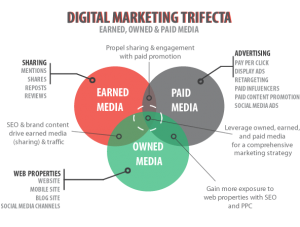
Technology and collaboration tools have become integral to today’s businesses.
Instead of being stuck in one organizational silo, modern-day Chief Information Officers (CIOs) and other executives are finding themselves collaborating with a number of other departments.
From marketing and customer service to accounting and human resources, IT leaders play a prominent role by facilitating the use of technology to improve overall performance.
Human resources is one particular area that is taking advantage of executive collaboration. For one, the human resources department has been one of the most affected by the digital revolution.
Chief Human Relations Officers (CHROs) or Chief People Officers are posting jobs online, training with cloud-based programs, deploying tech-driven employee engagement initiatives, and even using wireless presentation software such as Ubiq at recruitment events and meetings.
How can your organization benefit from CIO and HR Executives collaboration?
Recruitment
Many leaders in the tech world are concerned about a shortage of skilled workers in IT-related fields.
According to InformationWeek, 73% of small to mid-sized business reported struggling with an IT talent shortage.
How can CIOs and HR improve talent acquisition?
Search For Talent In More Innovative And Efficient Ways
For example, some recruiters have even used social networking platforms like LinkedIn to search for and connect with potential job candidates.
According to a 2013 study by the Society for Human Resource Management, over 77% of HR professionals use social media to recruit candidates.
Design Benefits Packages That Attract Talent
Organizations have started to offer more competitive and innovative employee benefits and perks to win the talent war.
Big tech companies like Facebook and Google have some of the most outrageous perks like free on-site haircuts, laundry and dry cleaning, a video arcade, and a ball pit.
Other examples of business that have gotten creative with their perks programs are iCracked and Dropcam.
The company iCracked gives employees free rides on the company yacht, while Dropcam gives each new hire and their families a helicopter ride with the boss.
Perks programs don’t have to be outrageous though. Often, they involve technology and are inspired by IT-provided employee data and analytics.
Some organizations are even using technology as a recruitment selling point. For instance, sales positions may offer employees wearable tech or mobile devices as part of their benefits package.
Employee Engagement
Companies are not only pressured to recruit top talent, but many struggle to keep their employees. Workers today are more keen to switch jobs than in the past.
According to one study, the majority of today’s college graduates will have had at least a dozen jobs before their 30s.
The likelihood that an individual will leave their current position increases when they are disengaged.
In fact, employees that have a low level of engagement are four times more likely to leave their jobs than their more engaged counterparts.
According to a Gallup survey, over two-thirds of the workforce are not engaged at work.
How are human resource departments addressing the engagement crisis? Many are addressing it with the help of IT leaders and technology. Here’s how:
Measuring Employee Satisfaction And Performance
Companies are investing more resources into data and analytics related to employee satisfaction and performance.
Pulse surveys are often used to measure employee engagement and happiness. Cloud applications, wearable tech, and other devices are being used to measure and improve employee productivity.
Gamifying Processes
To encourage use, tech-driven programs often employ gamification. Gamification uses the principles of game environments and applies them to non-game environments.
In business, this is often in the form of e-learning, training, or goal completion.
Giving Real-Time Feedback And Development Opportunities
Opportunities for growth and development are more important than ever to employees. Workers want to have real-time feedback and to be recognized for their achievements.
Based on a recent report, 65% of employees want more feedback and 69% would work harder when their efforts are recognized.
HR Data and Analytics
HR departments around the world are increasingly using data to measure employee engagement, but also, to improve decision-making and HR processes.
Companies that use HR data and analytics to assist in decision-making are two to three times more likely to have high-quality new hires, improved leadership development, and decreased turnover rates.
There are dozens of ways that HR metrics can improve processes and decision-making. Here are a few ways that tech can help:
Mining Resumes
Some large organizations may have hundreds of job applications submitted a day. It’s difficult to impossible to review each of them.
Instead, HR can use tech to mine resumes for specific items and identify the most promising candidates.
Accelerating Onboarding And Improving Training
Businesses lose money each day that a position remains vacant. When CIOs and HR Executives work together, they can design an accelerated onboarding process.
HR Executives can ensure that all the essential training components are covered, while CIOs supply them with the technology to streamline the process.
Turning Data Into Actionable Insight
When it comes to data, it can be advantageous for CIOs to partner with HR Executives.
CIOs may be able to easily accumulate the data about employee performance, recruitment, retention, and other HR statistics with their analytical skills.
However, HR Executives are a great resource for turning those numbers into meaningful insight.
Cloud and Mobile
More HR departments are using cloud tools to manage recruitment, training, and other related efforts.
In a recent study, 61% of organizations reported using cloud software for recruiting. The increased use of cloud and mobile technology has influenced the collaboration between many CIOs and HR Executives, and has become invaluable to overall business performance. Here’s how:
Improving Leadership Accessibility
For HR leaders, finding the next star employee may happen on the subway, at a conference, or some other out-of-office location.
Chance encounters can turn into a valuable business relationship now with the help of mobile devices and cloud technologies.
Working Remotely
Members of the workforce expect technology to be ingrained into several areas of the workplace.
The growing number of Millennials in the workplace, for example, is driving many mobile and tech initiatives. Flexibility and the ability to work remotely are becoming more valuable to today’s workforce.
Mobilizing processes to allow employees to work on the go is becoming more important to organizations than ever before.
Ongoing Mobile Training
Spending on corporate training initiatives has grown with the rising demand for e-learning, MOOCs, cloud-based collaboration tools, and other tech-based employee growth programs. Furthermore, mobile is playing a prominent role in HR training.
Increasing Productivity
At the end of the day, users want to use technology that is simple to use, seamless and can help get more done as little time as possible.
CIOs are playing more active roles in departments that may seem unrelated to technology. However, as tech usage and importance grows in the business world, so does their presence on the leadership team.
With many organizations struggling to win the talent war and engage employees, it is more important than ever for CIOs and HR Executives to pull their resources and work together.
Companies with a collaborative CIO and HR Executives’ relationship are most likely to come out on top.
Technology has become crucial to many human resource programs and processes. But it is all dependent on the leadership team on executing these practices.
Any Tips To Share?
What are some of the initiatives you’re currently taking to achieve your goals?
Business & Finance Articles on Business 2 Community(139)









